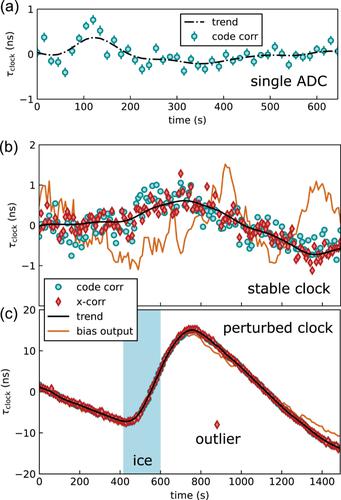当前位置:
X-MOL 学术
›
IET Radar Sonar Navig.
›
论文详情
Our official English website, www.x-mol.net, welcomes your feedback! (Note: you will need to create a separate account there.)
Time transfer via single-record TDoA measurements of GNSS satellites using direct cross-correlation and relative pilot code phases
IET Radar Sonar and Navigation ( IF 1.7 ) Pub Date : 2024-03-22 , DOI: 10.1049/rsn2.12557 Erik Busley 1 , Timotej Žuntar 1 , Jörg Borgmann 1 , Michael Krist 1
IET Radar Sonar and Navigation ( IF 1.7 ) Pub Date : 2024-03-22 , DOI: 10.1049/rsn2.12557 Erik Busley 1 , Timotej Žuntar 1 , Jörg Borgmann 1 , Michael Krist 1
Affiliation

|
Radar systems are evolving towards distributed receiver networks. As individual stations might be separated too far to install a cable link, novel methods are required to synchronise individual data records in the time domain. State-of-the-art GNSS receivers disciplining a highly stable oscillator are able to output a timing signal with several nanosecond accuracy solely using non-proprietary signals. However, they typically require a stable environment and become a major cost factor for receiver networks with a high number of nodes. A method is presented to passively synchronise data records via GNSS raw signals in a single record requiring only a GNSS antenna, an analogue-to-digital converter and computation hardware. The clock bias is estimated via the common view method with either full raw signal correlation or software-based code correlation of individual signals from the GPS, Galileo and BeiDou constellation with sub-nanosecond precision.
中文翻译:

使用直接互相关和相对导频码相位通过 GNSS 卫星的单记录 TDoA 测量进行时间传输
雷达系统正在向分布式接收器网络发展。由于各个站可能距离太远而无法安装电缆链路,因此需要新的方法来同步时域中的各个数据记录。最先进的 GNSS 接收器配备高度稳定的振荡器,仅使用非专有信号即可输出几纳秒精度的定时信号。然而,它们通常需要稳定的环境,并成为具有大量节点的接收器网络的主要成本因素。提出了一种通过单个记录中的 GNSS 原始信号被动同步数据记录的方法,仅需要 GNSS 天线、模数转换器和计算硬件。时钟偏差是通过通用视图方法估计的,该方法采用完整的原始信号相关性或来自 GPS、伽利略和北斗星座的各个信号的基于软件的代码相关性,精度达到亚纳秒级。
更新日期:2024-03-24
中文翻译:

使用直接互相关和相对导频码相位通过 GNSS 卫星的单记录 TDoA 测量进行时间传输
雷达系统正在向分布式接收器网络发展。由于各个站可能距离太远而无法安装电缆链路,因此需要新的方法来同步时域中的各个数据记录。最先进的 GNSS 接收器配备高度稳定的振荡器,仅使用非专有信号即可输出几纳秒精度的定时信号。然而,它们通常需要稳定的环境,并成为具有大量节点的接收器网络的主要成本因素。提出了一种通过单个记录中的 GNSS 原始信号被动同步数据记录的方法,仅需要 GNSS 天线、模数转换器和计算硬件。时钟偏差是通过通用视图方法估计的,该方法采用完整的原始信号相关性或来自 GPS、伽利略和北斗星座的各个信号的基于软件的代码相关性,精度达到亚纳秒级。



























 京公网安备 11010802027423号
京公网安备 11010802027423号